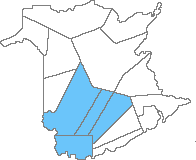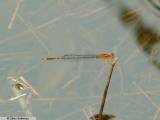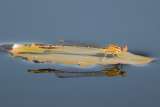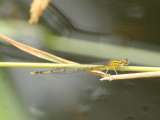
| Range/Distribution: | This species is currently only known from a few sites in Charlotte, York, Sunbury and Queens Counties. |
| Typical Flight Period: | late June to early September (records: Jun 29 - Sep 9) |
 |
|
||||||
 male |
 male |
 female |
|||
| small (52KB) |
large (154KB) |
(28KB) | small (46KB) |
large (120KB) |
|
| Description: |
The males of this species are quite distinct; however, one must keep in mind that
there are orange forms of female Forktails (Ischuras) that look somewhat similar. Mature male Orange Bluets are orange and black. The eyes are orange, the thorax is mostly orange with some black stripes and the abdomen appears mostly black from above. The abdomen has very little orange on the dorsal surface except for thin rings at the base of most abdominal segments and segment 9 (S9) is entirely orange. Young males have the same overall pattern as adult males, except they are pale blue rather than Orange. The females are variable from greenish-yellow to orangy-yellow with the top of the abdomen being mostly black with a small amount of colour at the tip of the abdomen (part of S9 and much of S10) The orange form of the female Eastern Forktail is the most likely damselfly to be confused with male Orange Bluets here in NB. It is very common throughout the province and occurs in a variety of habitat including the same habitat as Orange Bluets; however, they are quite easy to tell apart. Female Eastern Forktails are smaller than Orange Bluets and have orange at the base of the abdomen (the 3 segments closest to the thorax: S1, S2, most of S3) and have no orange on the top of the rest of the abdomen except for very thin rings at the base of the abdominal segments.
|
|